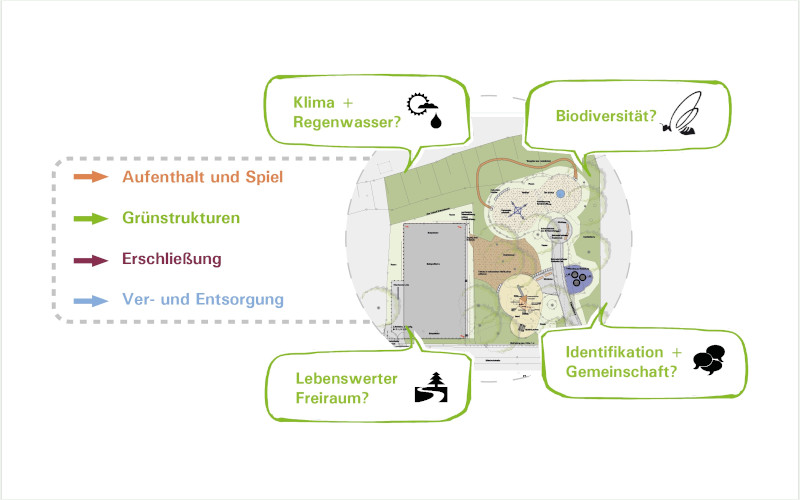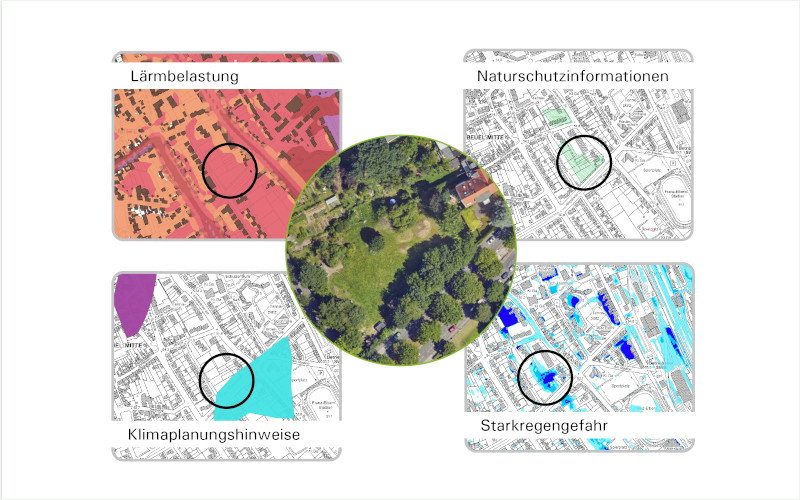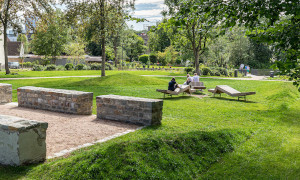Thinking about the aspects of green infrastructure in the planning means a plus to the everyday requirements of play areas.
Drought, heat, insect decline - since the summer of 2018 at the latest, it has been obvious to many that climate change and the loss of biodiversity are having drastic effects.
Children are dependent on quality open spaces. If there is a lack of sufficient open space, social and linguistic developmental disorders can occur, according to the children's study "Raum für Kinderspiel!" by the German Children's Fund. The vulnerability of children to heat stress is also high, as is that of senior citizens and the sick.
All the more reason to consider play areas as part of the green infrastructure and design them accordingly.
"Multicoding" on play areas
DIN 18034 "Open spaces for play" applies not only to legally designated play areas, but to areas suitable for play. The specifications for planting and experiencing nature touch on aspects of green infrastructure. However, there is significantly more 'multi-coding' possible.

Each individual area is then first considered as a building block of the green infrastructure system. For the basic evaluation, this means considering the location and integration into the urban fabric at a very early stage - when new plans or revisions are pending and budgets are being set.
In the meantime, most municipalities have their own climate adaptation concepts, heavy rain risk assessments, local mobility concepts, etc. There are biotope network strategies in NRW, at least at the state level, with area-specific statements or noise maps. If it is recognisable that the area can contribute to the solution, for example in the area of heavy rain prevention, by integrating functions, interdisciplinary courses of action and solutions are to be envisaged, also across jurisdictional boundaries. Many people - especially children - will benefit from the financial synergies that result from "multicoded" solutions.
Thinking about the aspects of green infrastructure during the planning process is a plus to the everyday requirements of play areas. Some requirements are completely new, others are simply given a different weight. This sounds like overloading the individual project, but examples show that synergies also create new possibilities - at the level of the district, neighbourhood and at the individual area. The implementation is quite different in each individual area.
Play and stay
- Offers in the surroundings
- Exposure
- Safety
- Multifunctionality
- Target group oriented
- Inclusion - low barriers
- Care and maintenance
- Lighting
Consensus-based planning with citizen participation and space structures that can be used in a variety of ways, even without equipment, are an important basis for sustainable play areas. Participation and diversity of use form the basis for social control, which counteracts possible vandalism and is strengthened in many municipalities by successful sponsorship programmes.
It is precisely the early inclusion of the aspects of care and maintenance in the planning, ideally in direct consultation with the responsible actors with their knowledge of experience, that contributes sustainably and in the long term to the conservation of resources. The combination of wooded areas, meadows and playgrounds into larger units simplifies maintenance.
Sustainability in design and materials has long been a requirement of tight budgets. When it comes to equipment elements, it is difficult to make environmentally conscious choices. Who dares to estimate whether the eco-balance over the entire life cycle of playground equipment with steel, wooden or recycled plastic posts is more positive? In the field of gardening and landscaping, the EPD environmental product declaration currently provides orientation in individual cases. It is seldom as easy to make an environmentally sound choice as it is with insect-friendly, energy-saving LED lighting.

Green structures
- Integration of the existing
- lively and diverse
- usable
- functional
- climate-adapted plant selection
- Care and maintenance
Climate-adapted plant selection
Play areas can assume an important function in the context of climate adaptation. They are cool spaces that can be reached via short distances in the neighbourhood and thus become more important for all residents. Even individual areas of at least 3 ha have a lasting cooling effect in the neighbourhood - depending on size and structure - up to at least 200 m into the development. Even if play areas rarely reach this size, the cooling effects of smaller areas can still be seen in the thermal images of climate adaptation concepts.
The integration of trees and shrubs is a matter of course in the design of play areas, ensuring shaded areas and habitats for birds and bats. However, playgrounds as stepping stones in the urban biotope network are not a matter of course. Especially for insects, extensive meadows or shrubbery can have a great effect on urban green spaces: for the players, this means experiencing nature and the senses. Extensive nibbling plantings with hazel and berry fruit should also be integrated into play areas.
The requirements of a climate-adapted plant selection raise new questions. Already now, tree plantings are to be carried out that will take over the climatic functions of the existing trees in the medium and long term: Shading and cooling. In species selection, biodiversity and climate requirements are often in conflict. The various aspects of green infrastructure require a balancing act. New elements such as tree infiltration trenches combine rainwater management with alternating humid tree locations.
Development
- Pathways inside and outside the site
- Functions
- Reduction of paved areas
- Type of paving (material, colour, ...)
- Slope and drainage
Use of rainwater
The smaller the margins, the higher the unavoidable proportion of paved surfaces due to the pressure of use alone. Paved areas can still be seepable or do not need to be connected to the sewer system if soil conditions are suitable. In the case of large play areas, clever path planning and allocation of functional areas is a basis for a high proportion of living vegetation areas with different play characteristics and climatic functions. If the individual area is integrated into a network of green paths, play and recreation areas in the neighbourhood and beyond, this demonstrably strengthens health and quality of life as well as sustainable local mobility.
Supply and disposal
- Connection possibilities to pipelines, canals, watercourses
- Exposure of the site
- Seepage of the subsoil
- Technical and economic possibilities
For properties with a runoff effective area of more than 800m², a proof of safety against damage-free flooding with a minimum 30-year rain event has to be provided since 2016. In addition, local authority flow path analyses define problem areas during heavy rainfall events. Against this background, playgrounds gain importance within the stormwater management for their built environment. Swales, infiltration trenches, tree infiltration trenches, etc. can be integrated into the play areas without the "rainwater systems" becoming a safety risk. Rainwater can also be used for water play facilities, taking into account design, technical and hygienic requirements. The "water management" in the play areas also increases the evaporation capacity and thus the climatic effect of the play areas, making them a building block in climate adaptation concepts.
Author: Martina Hoff, Landschaftsarchitektin bdla, Landschaftsarchitekturbüro Hoff Planung Ökologie Freiraum, Essen. The text appeared in the bdla association magazine "Landschaftsarchitekten" 3/2020.
- Latitude: 0
- Longitude: 0


